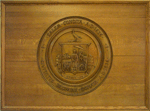Gallows Hill: Difference between revisions
No edit summary |
No edit summary |
||
| (3 intermediate revisions by the same user not shown) | |||
| Line 3: | Line 3: | ||
in the wooded land between Proctor and Pope Streets leading to Gallows Hill Park. | in the wooded land between Proctor and Pope Streets leading to Gallows Hill Park. | ||
Gallows Hill was known for its | The location of the hangings was made official in Jan. 2106 by the Gallows Hill Project, a group of seven scholars who announced that they were definitely certain the location is Proctor's Ledge, a wooded, city-owned area that abuts Proctor and Pope Streets. | ||
Gallows Hill was known for its [[Bonfires]], which took days to erect and would burn spectacularly for hours. One especially | |||
memorable one was in celebration of the end of World War II, on July 4, 1946. | memorable one was in celebration of the end of World War II, on July 4, 1946. | ||
In 1998, Mayor Stan Usovich considered Gallows Hill Park area as a new site for the Federal Street School (now called | In 1998, Mayor Stan Usovich considered Gallows Hill Park area as a new site for the Federal Street School (now called | ||
Bowditch School) which was renting the old St. James school building. The plan was rejected after much debate and discussion. | Bowditch School) which was renting the old St. James school building. The plan was rejected after much debate and discussion. | ||
For more on the bonfires of Gallows Hill, see the entry [[Bonfires]] on this wiki | |||
| Line 18: | Line 22: | ||
Vertical File in Salem Collection- '''Gallows Hill''' | Vertical File in Salem Collection- '''Gallows Hill''' | ||
[http:// | [http://Salem.noblenet.org/Record/1702718 Salem, Massachusetts, Vol. II] photo of Bonfire at Gallows Hill, p.116 | ||
"Site unknown: Author says witchcraft victims were not hanged atop Gallows Hill" ''Salem Evening News'' Oct. 31, 1997, p. A1 | "Site unknown: Author says witchcraft victims were not hanged atop Gallows Hill" ''Salem Evening News'' Oct. 31, 1997, p. A1 | ||
Latest revision as of 15:26, 6 October 2025
Though no public record has been found describing just where the witch trial victims were hung, most people agree it was in the Gallows Hill region of Salem, possibly the lower ledges. The 19 men and women were most likely hanged from a tree in the wooded land between Proctor and Pope Streets leading to Gallows Hill Park.
The location of the hangings was made official in Jan. 2106 by the Gallows Hill Project, a group of seven scholars who announced that they were definitely certain the location is Proctor's Ledge, a wooded, city-owned area that abuts Proctor and Pope Streets.
Gallows Hill was known for its Bonfires, which took days to erect and would burn spectacularly for hours. One especially memorable one was in celebration of the end of World War II, on July 4, 1946.
In 1998, Mayor Stan Usovich considered Gallows Hill Park area as a new site for the Federal Street School (now called Bowditch School) which was renting the old St. James school building. The plan was rejected after much debate and discussion.
For more on the bonfires of Gallows Hill, see the entry Bonfires on this wiki
See Also
Vertical File in Salem Collection- Gallows Hill
Salem, Massachusetts, Vol. II photo of Bonfire at Gallows Hill, p.116
"Site unknown: Author says witchcraft victims were not hanged atop Gallows Hill" Salem Evening News Oct. 31, 1997, p. A1
"The Greatest bonfire ever: Reminiscing about Gallows Hills", July 4, 1946, Salem Evening News, Sept. 17, 1996, p. B5
"Mayor considers Gallows Hill for school site" Salem News, Jan. 13, 1998, p. A8
"Federal Street group opposes plan" Salem Evening News, Feb. 16, 1998, p. C3
"Salem mayor drops plan for school at Gallows Hill" Salem Evening News, Feb. 24, 1998, p. A1
"Ground Zero: Proctor's Ledge confirmed as witch-execution site" Salem News, Jan. 12, 2016, p. 1
